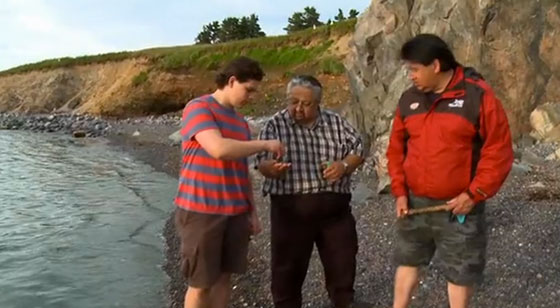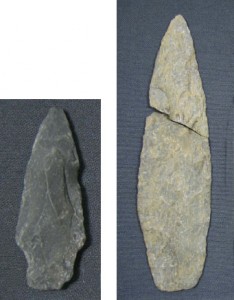
Nikanisk Ingonish Island

This projectile point (left) was found on the shoreline of St. George’s Bay, and is made of Ingonish Island rhyolite. The artifact on the right is a large biface (used as a spear point or knife) and also is made of Ingonish Island rhyolite. Its form suggests it is more than 3,000 years old. Artifacts like these have been found throughout Mi’kma’ki. From the collections of the Nova Scotia Museum, Archaeology Collections, Halifax, NS.
Ingonish Island is an important place, where both a quarry site and a presumed living site have been found. The quarry is the source for a rock, called Ingonish Island rhyolite, that has been used for thousands years and has been found in archaeological sites across Mi’kma’ki.
In the video shown here, Clifford Paul reports on one such artifact, an arrowhead found in the Cape Breton Highlands, which dates back some 4,500 years.
Excavations in 1975 by St. Francis Xavier archaeologist Ron Nash and his crew at the ancestral site at the Island showed a group of artifacts that were exclusively stone. While it is not a huge collection, it is significant because it spans thousands of years. The artifacts are presumed to have ranged in dates between 8,000 and 1,000 years ago based on their form. Together with evidence of Ingonish Island rhyolite artifacts from other sites, we know this has been an important place for a very, very long time.


 sharing our stories
sharing our stories
Hi, I have been researching Mi’kmaq use and occupation of Newfoundland (Ta’kam’kuk) for the past 40 years. Due to a poorly prepared case, the Conne River Band lost a Mi’kmaw land claims case in 2009 ? not sure of the date of decision, but the case name was R. v. Drew. Now, the only way to revive the Mi’kmaq claim in Newfoundland is via archaeological evidence. A rhyolite point from Ingonish found in St. George’s Bay really got my attention. Can you tell me how many other rhyolite artifacts have been recovered in Newfoundland and where. I am interested in the exact location the St. George’s Bay point was found. Any information would be appreciated.
Hi Jerry,
We would suggest contacting the Provincial Archaeology Office, http://www.btcrd.gov.nl.ca/department/contact_arts.html#pao
Also, you might be interested in this article by Helen Kristmanson, “The Application of X-ray Fluorescence Analysis to Archaeological Samples: A Case Study from Newfoundland and Cape Breton Island”. Canadian Journal of Archaeology / Journal Canadien d’Archéologie 28.2 (2004): 342–352.
We find Ingonish Island rhyolite at sites throughout Nova Scotia. Very cool!
MDCC Staff
Everyday when I wake up I look at Ingonish island,my great grandmother is Mikmaq and I often wonder if ingonish island was connected to the mainland of ingonish at one time and of course Did my ggrandma visit the island,i believe the island is private now.
Hey Ray ever been out there?
[…] https://www.mikmaweydebert.ca/…/ancestors-l…/ingonish-island/ […]
How far is the island from the mainland?
Has there been any move at all toward setting up an interpretive centre there??
Has it been determined that the island quarries are truly Mikmaq? Or were the occupants of these sites an earlier group from which the Mikmaq are descendant? Or both??
Thank you for this site and the opportunity to ask questions.
Hello Mr. Dawe,
Thank you for your questions. Our staff are not aware of any efforts to create an interpretive centre at Ingonish Island, which is not far from the mainland.
Mi’kmawey Debert does not separate ancestors in Mi’kma’ki. Oral histories and archaeology as well as other information affirm our ancestry from the people who have come before us in Mi’kma’ki. We believe this comes through across the content of our website.
MDCC Staff